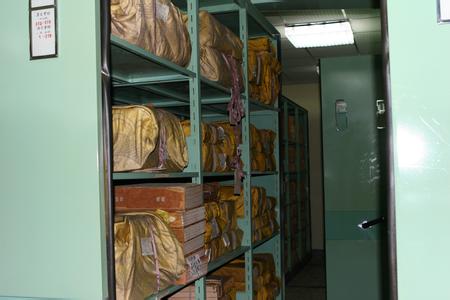David Porter
Ph.D. Candidate, Harvard University
I spent two months this summer at the First Historical Archives in Beijing. This post is intended to provide a few updates on Macabe Keliher’s superbly informative review of the FHA for Dissertation Reviews and a bit of information about using the archives to look at Manchu documents. Before I get to the practicalities, though, I’d like to encourage readers to take a look at my post (also at MSG), dealing with one of the documents I found in the archives, as an example of the treasures available to those of us who conduct research in Manchu, and a reflection on the mindset of the Qianlong emperor.
The main change since Macabe’s post linked above is that copies of digital documents can be given to you on a USB flash drive (that you supply) rather than in print. This service is free. The limit of 20 documents per research trip, defined as a calendar year, still applies. If you get documents in this form, there are a couple things to note. First, you will not be able to open them on a Mac. Second, they require a special program in order to open (even though they will seem to be jpegs). The FHA staff will provide you this program when you receive the documents, but you will likely find that it does not work right when you open it up. To fix the problem that you will inevitably have, you’ll need to go to the Region and Language settings in your Control Panel, click on the tab at the top that says “Administrative,” click on “Change system locale” and select “Chinese (simplified, PRC)” from the drop down menu (the specific instructions here are based on my computer, which runs Windows 7. Other versions of Windows should work relatively similarly). You’ll have to restart your computer for changes to take effect. After that, everything should work straightforwardly.
For using Manchu sources, specifically, there are a couple things to note. First, the major set of Manchu sources available are the Manchu lufu. These are the copies of memorials made by clerks for record-keeping purposes. Unlike Chinese lufu, Manchu lufu are generally pretty easy to read, but you do lose out on some of the features of the original memorial, like the author’s handwriting. Second, for some reason, the information that a search of the digital database will return about a Manchu document will not include any information in the date field. However, you can still easily check the date, and sort documents by date, by looking at a field (the name of which I’ve forgotten, but it’s also something about date or time) that gives the date as a numeric code. The first two digits will refer to the reign period (01 is Tianming, 02 is Tiancong, 03 Chongde, etc), the next two are the year, the next two are the month and the final three (always beginning with a 0) are the day. So 071901023 would be Qianlong 19.01.23, and 100711005 would be Xianfeng 07.11.05, and so forth. Finally the lack of the generic date field (which for Chinese documents will write out Qianlong 19.01.23 in addition to the numeric code) can often make it very quick to identify which of the documents your search returned are likely to be in Manchu, if you haven’t already narrowed your search by language, as the advanced search options allow. This may be especially useful for those researchers so unlucky as to not have be able to read Manchu; it’s an easy way to see which documents you won’t be able to use. But I recommend solving that problem through the longer, but far more rewarding solution: learn Manchu!


One Reply to “Notes from the Archives: The First Historical Archives of China”